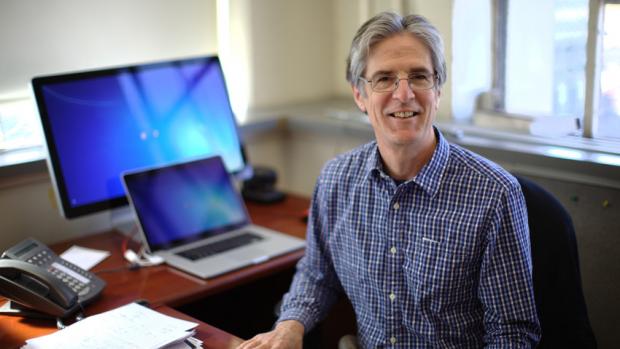American Academy of Arts and Sciences Elects Professor David Pine a Fellow

David Pine
The American Academy of Arts and Sciences (AAAS) has elected David Pine, chair of the NYU Tandon Department of Chemical and Biomolecular Engineering, to its 2018 class of individuals recognized for excellence across a wide range of disciplines and professions. He is one of only seven fellows selected this year for the Engineering Sciences and Technologies section of AAAS.
Pine is also a professor of physics in the NYU Faculty of Arts and Science and has made breakthroughs in the area of soft mesoscopic materials — those made from building blocks about a micrometer in size (or about 1/200th the width of a strand of a human hair).
These include the creation of techniques that prompt micro-particles to form ordered structures in a variety of materials — an advance that offers a method to improve micro-lasers and optical communications. About 10 years ago, his group discovered a new phenomenon in dynamical systems: Small particles in a viscous liquid do not undergo reversible trajectories when the system is sheared back and forth. Further work led to an even more important discovery, of a dynamical transition between reversible and irreversible trajectories. Their discovery of this “random organization” opened up a new area of research and stimulated activity by research groups around the world, and it may ultimately be useful for creating new optical materials.
More recently, his research group developed new kinds of microparticles with DNA arranged in orderly patches on the particle surfaces. These patches make it possible to assemble the particles into unique crystalline structures that are otherwise difficult or impossible to make. The team also developed “lock and key” microparticles, so-called because one set can precisely fit into the other. The techniques advance the engineering of blood and other cells, genetic material and proteins, and are also applicable for drug delivery systems as well as consumer products such as shampoo, shaving cream, paint, pigments, and plastics.
Early in his career, Pine and fellow researchers developed a light-scattering technique they called Diffusing-Wave Spectroscopy, which enabled measurements of the microscopic movements of small particles suspended in a liquid. It was particularly useful because it allowed measurements in opaque liquids for the first time. It became a standard technique and is now widely used to characterize materials like milk, paint, blood, and proteins.
“David Pine has made a number of first-rate contributions to the physics of soft matter, and I am proud that he is part of the NYU Tandon faculty,” said Dean Katepalli R. Sreenivasan. “I extend my heartfelt congratulations as he takes a place this year in the Engineering Sciences and Technologies section, to which he naturally belongs, in the American Academy of Arts and Sciences. The fellows of the Academy are very broad in their range of interests, and Dave fits very well there.”
The AAAS cited Pine’s contributions to beautiful mathematics, physics, chemistry, materials, and engineering. He has published more than 150 articles, has been a Guggenheim Fellow, and is a Fellow of the American Association for the Advancement of Science and of the American Physical Society.
The new class of fellows will be inducted at a ceremony this October in Cambridge, Massachusetts. AAAS members have included Benjamin Franklin (1781), Alexander Hamilton (1791), Maria Mitchell (1848), Charles Darwin (1874), Albert Einstein (1924), Margaret Mead (1948), Milton Friedman (1959), and Martin Luther King, Jr. (1966). Founded in 1780, the Academy honors exceptional scholars, leaders, artists, and innovators and engages them in sharing knowledge and addressing challenges facing the world.




